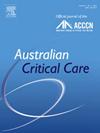2019冠状病毒病大流行后澳大利亚和新西兰重症监护虚拟就诊实践:一项两国调查
IF 2.7
3区 医学
Q2 CRITICAL CARE MEDICINE
引用次数: 0
摘要
入住重症监护病房(ICU)患者的家庭成员可能会经历不利的身体、心理和社会影响。虽然灵活的亲自探访旨在减少这些不利的家庭经历,但由于地理距离和他们自身的虚弱以及工作/照顾承诺,一些家庭遇到了挑战。虚拟访问(VV)是一种辅助或替代亲自访问的策略,可以解决访问不公平的问题。为了为未来的研究提供信息,我们的目标是记录当前(covid -19大流行后)澳大利亚和新西兰(ANZ) ICU中针对VV的ICU就诊实践和政策。方法我们进行了一项多中心、横断面、自我管理的电子调查,调查对象是澳新银行公立和私立医院成人/混合icu的首席医学主任或护士单元经理。调查的开展参考了证据基础、我们的经验和大流行期间进行的调查。采用描述性统计方法报告调查结果。结果总共收到了51个icu的调查回复,包括31个请求站点中的26个(84%)新西兰站点和162个请求站点中的25个(15%)澳大利亚站点(总体澳新银行响应率为26%)。虽然53%的icu发生了无限制访问(不限制访问时间或持续时间),但只有6家(12%)提供每天24小时的家庭访问。30个icu(59%)报告了一些VV的使用,尽管30个icu中有15个(50%)报告这种情况很少发生。在大流行期间使用VV的10个icu现在不再提供这种选择。VV面临的挑战包括硬件的有限可用性,软件的组织限制,以及如何进行VV的培训有限。结论目前,在澳大利亚和新西兰的icu中,面对面的探视往往受到探视时间长短的限制。在成人/混合icu中,使用VV来支持患者及其家属似乎有限,并且可能正在下降。减少获得疫苗的影响以及使用疫苗是否能改善以病人和家庭为中心的结果,是否能解决获得疫苗的不平等问题,是否应成为未来大流行病防范工作的一部分,应在今后的研究中加以探讨。本文章由计算机程序翻译,如有差异,请以英文原文为准。
Intensive care virtual visiting practices in Australia and New Zealand following the COVID-19 pandemic: A binational survey
Background
Family members of patients admitted to an intensive care unit (ICU) may experience adverse physical, psychological, and social impacts. Although flexible in-person visiting aims to reduce these adverse family experiences, some families encounter challenges due to geographical distances and their own frailty and work/caregiving commitments. Virtual visiting (VV), as an adjunct or alternative to in-person visiting, is a strategy that could address inequities of access.
Objectives
To inform future research, our objectives were to document current (post-COVID-19 pandemic) ICU visiting practices and policies specific to VV in ICUs across Australia and New Zealand (ANZ).
Methods
We conducted a multicentre, cross-sectional, self-administered electronic survey sent to the lead medical director or nurse unit manager of adult/mixed ICUs in public and private hospitals across ANZ. Survey development was informed by the evidence base, our experience, and surveys conducted during the pandemic. Descriptive statistics were used to report survey results.
Results
In total, survey responses were received from 51 ICUs, comprising 26 of 31 (84%) of requested New Zealand sites and 25 of 162 (15%) of Australian sites (overall 26% ANZ response rate). While unrestricted visiting (no restriction on time or duration of visit) occurred in 53% of ICUs, only six (12%) offered 24 h/day family access. Thirty ICUs (59%) reported some use of VV although 15 of 30 (50%) reported this occurred only rarely. Ten ICUs that used VV during the pandemic now no longer provide this option. Challenges to VV included limited availability of hardware, organisational restrictions on software, and limited access to training on how to conduct a VV.
Conclusions
Currently, in Australian and New Zealand ICUs, in-person visiting is often restricted by duration of visiting hours. The use of VV to support patients and their families in adult/mixed ICUs appears limited and may be declining. The impact of reduced access and whether use of VV improves patient- and family-centred outcomes, addresses access inequities, and should be part of future pandemic preparedness should be explored in future research.
求助全文
通过发布文献求助,成功后即可免费获取论文全文。
去求助
来源期刊

Australian Critical Care
NURSING-NURSING
CiteScore
4.90
自引率
9.10%
发文量
148
审稿时长
>12 weeks
期刊介绍:
Australian Critical Care is the official journal of the Australian College of Critical Care Nurses (ACCCN). It is a bi-monthly peer-reviewed journal, providing clinically relevant research, reviews and articles of interest to the critical care community. Australian Critical Care publishes peer-reviewed scholarly papers that report research findings, research-based reviews, discussion papers and commentaries which are of interest to an international readership of critical care practitioners, educators, administrators and researchers. Interprofessional articles are welcomed.
 求助内容:
求助内容: 应助结果提醒方式:
应助结果提醒方式:


